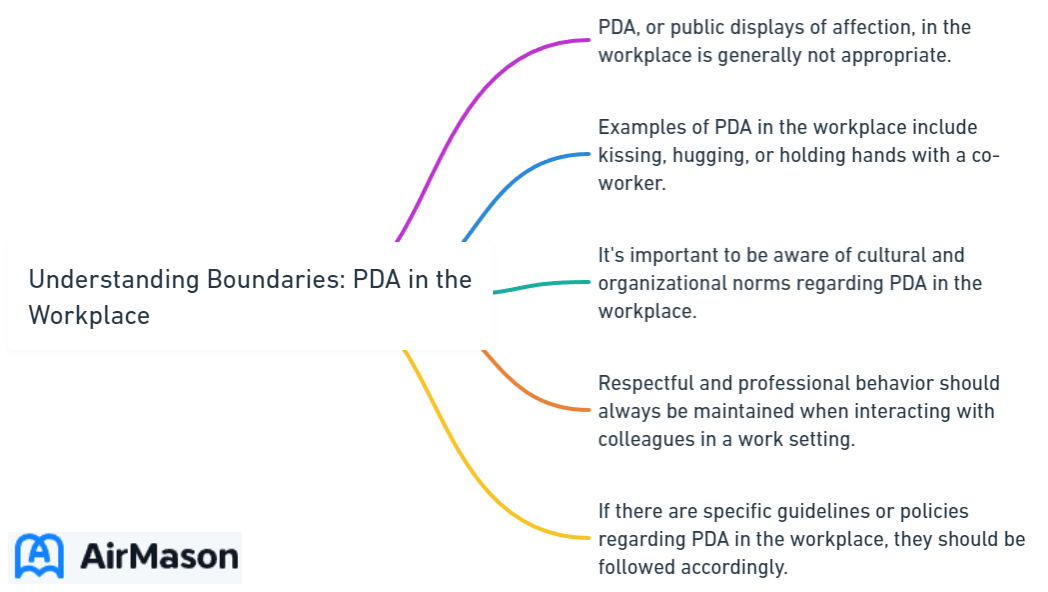
Understanding boundaries is crucial in any professional setting, and this includes the topic of personal displays of affection (PDA) in the workplace. While PDA is commonly known in a romantic context, it can also manifest in professional environments, which can have both positive and negative consequences. By defining PDA in the workplace and understanding the importance of respecting boundaries, employees and employers can create a harmonious work atmosphere that promotes professionalism and productivity.
Defining PDA in the workplace involves understanding the different forms it can take, such as public displays of affection between colleagues or inappropriate behavior that crosses professional boundaries. Recognizing the impact of PDA in the workplace is essential, as it can result in a disruption of the professional environment and create an uncomfortable atmosphere for other employees. Understanding and respecting boundaries is key to maintaining a healthy and respectful workplace.
To effectively set boundaries in the workplace, clear policies and guidelines need to be established. These policies should communicate expectations regarding PDA and ensure that all employees are aware of what is considered appropriate behavior. Open communication about boundaries between employers and employees is also crucial. By establishing boundaries and fostering a professional environment, the negative consequences of PDA can be minimized.
Violating PDA boundaries in the workplace can have serious consequences. Disciplinary actions may be taken, depending on the severity of the behavior. PDA can negatively affect professional relationships, leading to strained dynamics and potential conflicts. It is important for individuals to realize the potential impact of their actions and the need to maintain professionalism in the workplace.
Handling PDA issues in the workplace requires effective strategies. Mediation and conflict resolution techniques can be employed to address conflicts arising from PDA. Training and education programs focused on workplace conduct and professionalism can also be beneficial in preventing and addressing PDA-related issues.
Understanding and respecting boundaries regarding PDA in the workplace is crucial for maintaining a professional and harmonious work environment. By defining PDA, recognizing its impact, setting clear boundaries, implementing consequences for violations, and employing effective strategies for handling issues, employers and employees can ensure a respectful and productive workplace for everyone.
What are Personal Displays of Affection ?
Personal Displays of Affection (PDA) in the workplace, a subject that has raised eyebrows and sparked debate. Let’s dive into what exactly constitutes PDA and how it manifests within professional settings. From defining PDA in the workplace to exploring its implications, this section will shed light on the boundaries and challenges that arise when personal and professional spheres intersect. Get ready to uncover the nuances and considerations surrounding PDA in the workplace, and discover why it is such a noteworthy topic in today’s work environment.
Defining PDA in the Workplace
In the workplace, a key aspect of maintaining a professional environment is defining Personal Displays of Affection (PDA).
PDA in the workplace refers to any physical or verbal expressions of affection that exceed what is considered appropriate in a professional setting. This can include actions such as hugging, kissing, holding hands, or making romantic comments towards colleagues.
Understanding and clearly defining PDA in the workplace is essential for several reasons. It helps prevent disruption in the professional environment, keeps distractions at bay, and ensures that all employees feel respected and included. By establishing guidelines on what is considered acceptable, employees can focus on their work and maintain a productive atmosphere.
To effectively define PDA in the workplace, organizations should establish explicit policies and guidelines. These guidelines should clearly outline what types of behavior are considered appropriate and inappropriate. By communicating these expectations to employees, any confusion or misunderstandings can be avoided.
Defining PDA in the workplace not only helps create a comfortable work atmosphere for everyone, but also enhances employee well-being and contributes to the cultivation of positive professional relationships. By maintaining a professional environment through clear definitions and guidelines, organizations can foster a harmonious workplace.
If you’re seeking guidance in crafting a comprehensive PDA (Public Displays of Affection) policy for your company, consider consulting the Amazon employee dating policy. This valuable resource can provide you with insights and best practices to create a well-structured policy that defines acceptable behaviors in the workplace while addressing matters of personal relationships among colleagues. By studying Amazon’s approach, you can tailor your own PDA policy to ensure a professional and respectful work environment, promoting a culture of professionalism and adherence to company standards.

Why is Understanding and Respecting Boundaries Important in the Workplace?
Understanding and respecting boundaries in the workplace is crucial for maintaining a healthy and productive work environment. Here are the key reasons why this is important:
- Professionalism: Respecting boundaries promotes professionalism in the workplace. It sets clear expectations for appropriate behavior and helps create a respectful and comfortable atmosphere for all employees.
- Preventing Harassment: Understanding and respecting boundaries is essential for preventing harassment in the workplace. It ensures that interactions and relationships between colleagues are consensual, respectful, and free from any form of unwelcome or inappropriate behavior.
- Establishing Trust: When employees feel that their boundaries are respected, it helps establish trust among team members. They feel safe and comfortable expressing their ideas, concerns, and opinions, leading to better collaboration and teamwork.
- Productivity and Focus: Clear boundaries enable employees to maintain focus and productivity. When personal boundaries are respected, individuals can concentrate on their tasks and responsibilities without unnecessary distractions or intrusions.
- Work-Life Balance: Understanding boundaries helps maintain a healthy work-life balance. It ensures that personal time and space are respected, preventing work-related stress and burnout. This balance contributes to employee well-being and overall job satisfaction.
- Conflict Prevention: Respecting boundaries reduces the likelihood of conflicts arising in the workplace. When individuals understand and adhere to boundaries, misunderstandings and disagreements are minimized, fostering a more harmonious work environment.
- Equal Opportunity: Respecting boundaries ensures that all employees have equal opportunities for growth and success. It prevents favoritism, discrimination, or exclusion based on personal relationships or preferences.
- Legal Compliance: Understanding and respecting boundaries is essential for legal compliance. It helps organizations adhere to laws and regulations related to harassment, discrimination, and privacy in the workplace.
- Positive Company Culture: A workplace that values and respects boundaries cultivates a positive company culture. It promotes a sense of fairness, respect, and inclusivity, leading to higher employee morale, engagement, and retention.
- Customer and Client Relations: Respecting boundaries extends beyond internal relationships. It also applies to interactions with customers and clients. Maintaining appropriate boundaries ensures professionalism and fosters positive relationships with external stakeholders.
By understanding and respecting boundaries in the workplace, organizations can create a supportive, inclusive, and productive environment that benefits both employees and the overall success of the company.

The Impact of PDA in the Workplace
From disrupting the professional environment to creating an uncomfortable work atmosphere, the impact of PDA in the workplace is more significant than we might realize. It’s crucial to understand how Public Displays of Affection can affect the dynamics within an office setting. As we dive into the sub-sections, we’ll uncover the ways in which PDA can disturb the professional flow and contribute to an uncomfortable atmosphere, shedding light on the importance of addressing these boundaries in the workplace.
Disruption of Professional Environment
In the workplace, the disruption of the professional environment can be caused by personal displays of affection (PDA). This disruption occurs when employees engage in romantic gestures, such as kissing or hugging, that are inappropriate for the workplace setting.
One major consequence of this disruption is the negative impact it has on the overall work atmosphere. When colleagues witness PDA, it can create an uncomfortable environment, causing distractions and affecting productivity. It can blur the boundaries between personal and professional relationships, leading to potential conflicts and favoritism within the workplace.
To address the disruption of the professional environment caused by PDA, it is necessary to establish clear policies and guidelines. These policies should explicitly state what behavior is acceptable and what is not. By communicating these expectations to employees, it ensures that everyone is aware of the boundaries, helping to maintain a professional and respectful workplace.
If PDA boundaries are violated, there should be consequences in place to address the issue. These may include disciplinary actions, such as warnings or even termination, depending on the severity of the behavior. Violating PDA boundaries can also strain professional relationships, causing discomfort and potential tension among colleagues.
To handle PDA issues effectively, mediation and conflict resolution strategies can be employed. This allows for open communication and understanding between the individuals involved, helping to resolve any conflicts that may arise. Providing training and education on the importance of understanding boundaries and the impact of PDA in the workplace can help prevent future disruptions.
The disruption of the professional environment caused by PDA can have negative consequences on the overall work atmosphere and professional relationships. By establishing clear policies, enforcing consequences, and implementing strategies for handling PDA issues, workplaces can maintain a respectful and productive environment.
Uncomfortable Work Atmosphere
An uncomfortable work atmosphere in the workplace can have a detrimental effect on employee morale, productivity, and overall job satisfaction. It is crucial to address the following factors that can contribute to such an uncomfortable work atmosphere:
- Lack of communication: A lack of communication between employees and management can result in misunderstandings and conflicts, leading to tension and discomfort in the workplace.
- Poor leadership: Ineffective or unapproachable leaders can create an uncomfortable work atmosphere. When employees feel unsupported or undervalued by their leaders, it can lead to feelings of negativity and unease.
- Bullying or harassment: Instances of bullying or harassment can create a toxic work environment, resulting in an uncomfortable atmosphere. Such behavior erodes trust among colleagues and causes individuals to feel anxious, stressed, and uneasy.
- Unclear expectations: When employees are uncertain about their roles, responsibilities, or what is expected of them, it can create a sense of unease and insecurity. Lack of clarity can lead to confusion, mistakes, and an overall uncomfortable work atmosphere.
- Inequality and favoritism: The perception of inequality in terms of promotions, assignments, or recognition can generate tension and discomfort among employees. If favoritism is evident, it can lead to feelings of resentment and animosity.
Organizations should prioritize open and transparent communication, provide leadership training, enforce zero-tolerance policies for bullying and harassment, and ensure that expectations are clearly communicated. These measures are essential in creating a positive and comfortable work atmosphere for all employees.

Setting Boundaries in the Workplace
Setting boundaries in the workplace is crucial for maintaining a professional environment. In this section, we will explore effective strategies for establishing clear policies and guidelines, ensuring that both employers and employees are on the same page. We will also discuss the importance of transparent communication in communicating expectations to employees, fostering a positive and productive work culture. So, let’s dive in and discover the key elements behind creating strong workplace boundaries.
Establishing Clear Policies and Guidelines
Establishing clear policies and guidelines is crucial in maintaining a professional and respectful work environment. Here are some key points to consider:
- Identify boundaries: Define what is acceptable and unacceptable behavior in the workplace. This can include guidelines on personal displays of affection, appropriate language, and professional conduct.
- Involve employees: Seek input from employees when establishing policies and guidelines. This promotes a sense of ownership and ensures that expectations are clear to everyone.
- Provide written documentation: Clearly outline the policies and guidelines in a written document that is easily accessible to all employees. This helps eliminate any confusion or ambiguity.
- Offer training: Conduct training sessions to educate employees about the policies and guidelines. This includes explaining the reasons behind them and providing examples of appropriate and inappropriate behavior.
- Communicate regularly: Reinforce the importance of the policies and guidelines through regular communication. This can be done through team meetings, newsletters, or email reminders.
By establishing clear policies and guidelines, organizations can create a work environment where boundaries are respected, and professional behavior is upheld. This fosters a positive and productive atmosphere, ensuring that all employees can thrive and work together effectively.
Historically, the need for establishing clear policies and guidelines in the workplace has been recognized for many years. As far back as the early 20th century, companies started implementing formal codes of conduct to maintain discipline and professionalism among their employees. Over time, the importance of these policies has only grown, as organizations strive to create inclusive and respectful workplaces that uphold ethical standards and promote healthy working relationships.
For valuable insights into enhancing organizational efficiency and productivity within your company, we invite you to explore our article discussing the No Eating at Workplace policy with template. This resource offers practical guidance on establishing guidelines that promote a clean and efficient workspace while encouraging healthier eating habits. By delving into this article, you can gain a deeper understanding of how such policies can positively impact your workplace environment, fostering a culture of productivity and well-being among your employees.
Communicating Expectations to Employees
In order to ensure a productive and respectful workplace environment, it is essential for employers to communicate their expectations to employees effectively. This can be achieved by incorporating various strategies:
1. Clearly stating policies and guidelines: Employers should clearly establish and communicate comprehensive policies regarding boundaries and conduct in the workplace. These policies should be transparent and easily accessible to all employees.
2. Providing written documentation: Employers can develop employee handbooks or manuals that clearly outline expectations, rules, and regulations. This written documentation should be readily available and easily accessible to all employees.
3. Conducting regular meetings: Employers should schedule regular meetings with employees to discuss expectations, address concerns, and provide updates on company policies. These meetings provide opportunities for open communication and ensure that employees understand the expectations set by the organization.
4. Offering training and education: Employers can arrange training sessions or workshops to educate employees on appropriate workplace behavior and the importance of respecting boundaries. This helps foster a positive work culture and ensures that everyone shares the same understanding of expectations.
5. Encouraging open dialogue: Employers should create an environment where employees feel comfortable expressing their concerns or seeking clarification on expectations. Promoting regular open dialogue reinforces communication channels and ensures that expectations are well-understood.
By effectively communicating expectations to employees, employers can establish a harmonious work environment, promote professionalism, and minimize potential conflicts or misunderstandings.
To summarize, employers should prioritize clear communication of expectations through policies, documentation, meetings, training, and open dialogue. This creates a strong foundation for a respectful and productive workplace.
Consequences of Violating PDA Boundaries in the Workplace
When it comes to PDA in the workplace, crossing the boundaries can have serious consequences. In this section, we’ll dive into the aftermath of violating PDA boundaries, exploring disciplinary actions that can be taken and the potential impact on professional relationships. Prepare to uncover the real-life repercussions and discover why maintaining professionalism in the workplace is crucial for both individuals and organizations. Let’s explore the weighty outcomes of disregarding PDA boundaries and the ripple effects it can create.
Disciplinary Actions
Disciplinary actions play a crucial role in maintaining a professional and respectful work environment. When employees breach boundaries, it is essential to address the issue and implement appropriate measures to prevent its recurrence. Here are several potential disciplinary actions that can be employed:
- Verbal warning: For less severe cases, providing a verbal warning serves as a reminder of the boundaries and expectations within the workplace.
- Written warning: If the inappropriate behavior persists or worsens following a verbal warning, a written warning can be issued. This formalizes the disciplinary action and imposes a more serious consequence.
- Suspension: In more serious instances, a temporary suspension from work may be necessary. This grants the employee an opportunity to reflect on their actions and emphasizes the gravity of the violation.
- Demotion: If the violation is recurrent or significantly detrimental to the workplace, demotion can be considered as a disciplinary action. This may involve a reduction in job responsibilities or a lower position within the company.
- Termination: In extreme cases or when all other disciplinary actions have proven unsuccessful, termination of employment may be inevitable. This is the most severe consequence and is reserved for instances where the violation fundamentally undermines the work environment.
Employers need to effectively communicate the consequences of boundary violations to their employees. This practice helps foster and sustain a professional atmosphere while ensuring that everyone comprehends the importance of respecting workplace boundaries.
Effects on Professional Relationships
The effects on professional relationships caused by personal displays of affection (PDA) in the workplace can be significant. Here are some ways in which PDA can impact professional relationships:
- Decreased productivity: Engaging in PDA in the workplace can distract employees from their tasks and responsibilities, leading to a loss of focus and reduced overall productivity.
- Resentment among coworkers: Excessive displays of affection between colleagues can create discomfort and resentment among other employees, resulting in a strained work environment and negative effects on team dynamics.
- Perception of favoritism: When PDA occurs between colleagues in a hierarchical relationship, such as a supervisor and subordinate, it can create an impression of favoritism. This perception undermines trust and the integrity of the workplace.
- Jeopardizing professionalism: PDA blurs the boundaries between personal and professional relationships, causing a decline in professionalism and lack of respect for workplace norms and expectations.
It is vital for employees to understand the potential effects of PDA on their professional relationships. By maintaining appropriate boundaries, a more respectful and conducive work environment can be ensured, contributing to improved collaboration and overall job satisfaction.
If yo are looking for ways to increase the productivity of employees at the workplace we suggest implementing a flexible working hours policy. A it can greatly enhance productivity by allowing employees to align their work schedules with their natural rhythms and peak energy levels. When individuals can choose when they are most productive, they tend to complete tasks more efficiently and with greater enthusiasm. Moreover, the reduced stress associated with a better work-life balance can result in higher job satisfaction and increased commitment to the organization, ultimately leading to improved productivity across the board.
Fact: According to a survey conducted by CareerBuilder, 39% of employees admitted to dating a coworker at least once during their career, highlighting the prevalence of personal relationships in the workplace.
Strategies for Handling PDA Issues in the Workplace
When it comes to dealing with PDA in the workplace, having effective strategies in place is key. In this section, we’ll explore two essential approaches: mediation and conflict resolution, and training and education. Learn how these strategies can help foster a harmonious work environment and ensure that boundaries are respected. So grab a cup of coffee and let’s dive into these practical solutions for handling PDA issues at work.
Mediation and Conflict Resolution
Mediation and conflict resolution play a crucial role in the workplace, allowing organizations to resolve disputes and foster a harmonious work environment. Instead of allowing conflicts to escalate and negatively impact productivity and employee well-being, organizations can employ effective strategies to address issues in a fair and unbiased manner.
One important aspect of mediation is that it encourages active communication between parties involved in the conflict. Mediation promotes open dialogue, enabling individuals to express their concerns and viewpoints. This leads to a better understanding of each other’s perspectives. Mediators, who are trained professionals, facilitate this process and help guide the conversation towards a mutually agreeable resolution.
In cases where conflicts arise due to misunderstandings or differences in opinions, mediation can bring about a sense of clarity and enable parties to find common ground. This can be achieved through active listening, brainstorming solutions, and exploring alternatives that accommodate both parties’ needs and interests.
Mediation and conflict resolution techniques not only address immediate issues but also promote long-term relationship building. By providing a safe and neutral space for discussions, mediation helps restore trust and fosters a sense of inclusivity and collaboration among employees.
Implementing mediation and conflict resolution strategies in the workplace can lead to a more positive and productive work environment. It demonstrates an organization’s commitment to resolving disputes amicably and ensures that conflicts are handled fairly and equitably. Ultimately, this enhances employee satisfaction and overall team cohesion.
Training and Education
- Comprehensive training programs: It is crucial for companies to implement comprehensive training programs that equip employees with the necessary knowledge and understanding of appropriate boundaries within the workplace. These programs can cover various topics including professional conduct, respect for personal space, and the potential impact of PDA on the work environment.
- Workshops and seminars: Organizing workshops and seminars focused on raising awareness about PDA can effectively educate employees on the importance of maintaining professionalism and respecting boundaries. These sessions can involve discussions, case studies, and interactive activities to actively engage participants.
- Role-playing exercises: By incorporating role-playing exercises into training sessions, employees can practice responding to different PDA scenarios. This enables them to develop the skills and confidence needed to effectively address and mitigate PDA incidents.
- Employee handbooks: Clear guidelines and policies regarding PDA should be included in the company’s employee handbooks. It is essential for these materials to be easily accessible and regularly communicated to all employees to ensure awareness and compliance.
- Ongoing education: Continuous education and reinforcement of workplace boundaries are crucial. To keep employees informed and vigilant about maintaining professionalism, companies can provide regular updates and reminders through newsletters, emails, or dedicated training sessions.
- Online resources: Utilizing online platforms, companies can offer training modules, quizzes, and resources on PDA and workplace boundaries. This provides employees with convenient access to educational materials, strengthening their understanding of appropriate conduct.
- Feedback and evaluation: Actively seeking feedback from employees regarding their training experiences and continuously evaluating the effectiveness of training programs is important. This enables companies to make adjustments and improvements to ensure that the education initiatives remain relevant and impactful.
Frequently Asked Questions
What are empowering borders?
Empowering borders refer to the healthy boundaries that you set around different aspects of your life, such as your time, emotions, body, and mental health. These boundaries ensure that you are not being used or manipulated by others and protect your overall well-being.
How do boundaries impact our emotional well-being?
Boundaries play a crucial role in maintaining our emotional well-being. By setting clear boundaries, we can protect ourselves from being taken advantage of and prioritize our own needs and emotions. This helps prevent resentment, anger, and burnout, leading to better emotional health and overall happiness.
What role do material possessions play in setting boundaries?
Material possessions can be a part of setting boundaries. It involves being clear about what you are comfortable sharing or lending to others and establishing limits around the use of your items. This helps protect your valuables and maintain healthy relationships based on respect.
What are some signs of unhealthy boundaries?
Signs of unhealthy boundaries include feeling vulnerable to being used, over-committing your time to others, having lower self-esteem and critical inner dialogue, feeling exhausted or burnt out, having a hard time saying “no,” feeling guilty for expressing boundaries, changing yourself to fit in with different people, and taking on other people’s problems as your own.
How can we manage our emotional energy through boundaries?
Managing our emotional energy through boundaries involves recognizing and honoring our own personal limits when it comes to emotional engagements. Setting boundaries in emotional interactions helps prevent emotional exhaustion, protects our well-being, and allows us to prioritize our own emotional needs.
Why is owning our time important for setting healthy boundaries?
Owning our time is essential for setting healthy boundaries because it allows us to prioritize ourselves and our needs. By being in control of our time, we can allocate it wisely, ensuring that we have enough time for self-care, personal growth, and maintaining healthy relationships.
